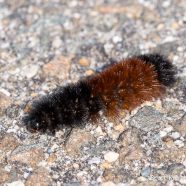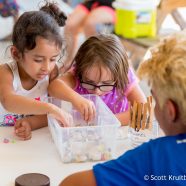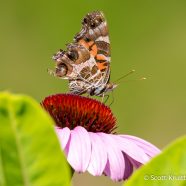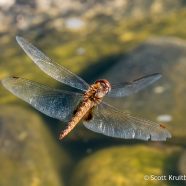Woolly Bear Season
Yep, it’s that time again – here’s a Woolly Bear caterpillar (Pyrrharctia isabella) that I saw crossing the road last week. In this case I think we can say that its goal was definitely to get to the other side. If you have not encountered any of them before the old story goes that more extensive black covering the body means it will be a colder and snowier winter will be for us, and the more brown a caterpillar has the warmer it will be. This one seems like a relatively balanced individual, so maybe we will all end up happy this winter. Scott Kruitbosch Conservation &...
Read MoreJuvenile Red-tailed Hawk
This juvenile Red-tailed Hawk (Buteo jamaicensis) is a very intriguing bird. These photos are as close as they appear, and it paid zero attention or regard to anyone or anything going on around it. The hawk enjoys sitting on wires and poles, occasionally glancing at someone if they are very loud or very close in a more curious than scared way. It seems likely that this goes beyond a case of being “young and dumb” which happens often enough in raptors with juvenile birds being too bold, too trusting, or too confident. This is probably a bird who grew up in an urban environment...
Read MorePleasure Beach Teaching
Pleasure Beach teaching continues as the Bridgeport WildLife Guards are really reaching the people heading to the shore these hot summer days during the height of vacation season. A varied audience of fishermen, beachgoers and sunbathers, families and children, and naturalists are all interacting with our crew by taking brochures about birds like the American Oystercatcher or Piping Plover, signing the Be A Good Egg pledge to help protect waterbirds on our beaches, or enjoying some of the hands-on activities the Guards have to offer. Let’s take a look… Amazingly there are only a...
Read MoreTattered Lady
The American Painted Lady (Vanessa virginiensis) is best identified when nectaring like this by the two large eyespots on the ventral hindwing. The very similar Painted Lady (Vanessa cardui) would have four smaller eyespots in the same place. This individual is tattered and torn, experiencing some wear and tear after being busy on the wing for probably only a couple weeks, or a few at most. Adult life spans are short for many of our butterflies, and they have a lot to get done in such a small window, which makes it all the more important to have plentiful, widespread and organic food...
Read MoreSpot-winged Glider
I finally captured a Spot-winged Glider (Pantala hymenaea) on the wing, and in this case it while the dragonfly was ovipositing – laying eggs in this pool. You can clearly see the basal spots on the inside of the hindwings along with some wear. Flying around the world must get a bit tiring… Scott Kruitbosch Conservation & Outreach Coordinator
Read More








